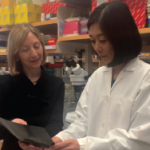
“We understand that many of the pathways by which immune cells ‘talk’ to other cells are potentially used by bone cells to talk to one another,” says Antonios O. Aliprantis, MD, assistant professor of medicine, and director of the Brigham and Women’s Osteoarthritis Center, Boston. “It follows, then, that if we could find these molecules that either bone cells use to talk to one another or immune cells use to talk to bone cells, we may be able to find new potential targets.”
Pivotal Work by Pioneers
The first milestone in understanding the structural damage in RA came in 1998 with the publication of a paper by Ellen M. Gravallese, MD, Steven Goldring, MD, and colleagues, in which they showed definitively the presence of osteoclasts at the pannus–bone interface in the joints of RA patients.1 In 1984, Bromley and Wooley had described TRAP-positive multinucleated cells, a marker of osteoclasts, in tissue sections from patients with RA, but the real wave of knowledge reached critical mass with the advent of modern scientific techniques.5
Dr. Gravallese, currently the Myles J. McDonough Chair in Rheumatology, University of Massachusetts Medical School, Worcester, Mass., recalls, “The rheumatology community was initially skeptical of the importance of our findings, so we felt it was essential to try to understand the pathways driving the differentiation of osteoclasts at these sites.” Dr. Gravallese and colleagues, in collaboration with Christophe Benoist, MD, PhD, professor of microbiology and immunobiology at Harvard Medical School, Boston, showed the link between RANKL, osteoclastogenesis and bone erosion by inducing inflammatory arthritis in RANKL knockout mice and demonstrating that these mice were protected from articular bone loss.2 In parallel experiments, Georg Schett, MD, PhD, Kurt Redlich, MD, and colleagues from the Medical University and the Institute of Molecular Pathology in Vienna, Austria, and the University of Athens (Georg Kollias, PhD), showed that in a different osteoclast-deficient mouse, the c-Fos-deficient mouse, articular bone was also protected from erosion in a TNF-driven arthritis model.3
‘We are beginning to understand that there is an inflammatory component to osteoarthritis.’
In addition, in the late 1990s, the orthopedist/immunologist Hiroshi Takayanagi and colleagues found that synovial macrophages were capable of differentiating into osteoclasts, and posited that this was likely contributory to the bone erosion seen in RA.6 Dr. Takayanagi’s group has also made additional major contributions to this area of investigation.
